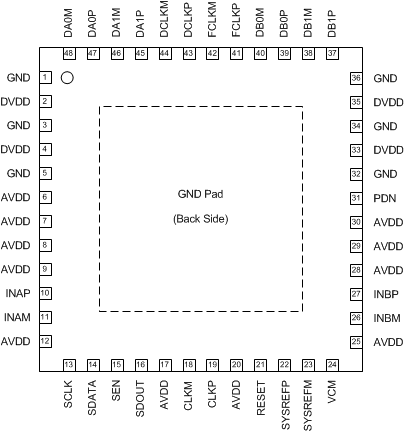SBAS671C July 2014 – March 2016 ADC3241 , ADC3242 , ADC3243 , ADC3244
PRODUCTION DATA.
- 1 Features
- 2 Applications
- 3 Description
- 4 Revision History
- 5 Device Comparison Table
- 6 Pin Configuration and Functions
-
7 Specifications
- 7.1 Absolute Maximum Ratings
- 7.2 ESD Ratings
- 7.3 Recommended Operating Conditions
- 7.4 Thermal Information
- 7.5 Electrical Characteristics: ADC3241, ADC3242
- 7.6 Electrical Characteristics: ADC3243, ADC3244
- 7.7 Electrical Characteristics: General
- 7.8 AC Performance: ADC3241
- 7.9 AC Performance: ADC3242
- 7.10 AC Performance: ADC3243
- 7.11 AC Performance: ADC3244
- 7.12 Digital Characteristics
- 7.13 Timing Requirements: General
- 7.14 Timing Requirements: LVDS Output
- 7.15 Typical Characteristics: ADC3241
- 7.16 Typical Characteristics: ADC3242
- 7.17 Typical Characteristics: ADC3243
- 7.18 Typical Characteristics: ADC3244
- 7.19 Typical Characteristics: Common
- 7.20 Typical Characteristics: Contour
- 8 Parameter Measurement Information
-
9 Detailed Description
- 9.1 Overview
- 9.2 Functional Block Diagram
- 9.3 Feature Description
- 9.4 Device Functional Modes
- 9.5 Programming
- 9.6
Register Maps
- 9.6.1 Summary of Special Mode Registers
- 9.6.2
Serial Register Description
- 9.6.2.1 Register 01h
- 9.6.2.2 Register 03h
- 9.6.2.3 Register 04h
- 9.6.2.4 Register 05h
- 9.6.2.5 Register 06h
- 9.6.2.6 Register 07h
- 9.6.2.7 Register 09h
- 9.6.2.8 Register 0Ah
- 9.6.2.9 Register 0Bh
- 9.6.2.10 Register 0Eh
- 9.6.2.11 Register 0Fh
- 9.6.2.12 Register 13h (address = 13h)
- 9.6.2.13 Register 15h
- 9.6.2.14 Register 25h
- 9.6.2.15 Register 27h
- 9.6.2.16 Register 41Dh
- 9.6.2.17 Register 422h
- 9.6.2.18 Register 434h
- 9.6.2.19 Register 439h
- 9.6.2.20 Register 51Dh
- 9.6.2.21 Register 522h
- 9.6.2.22 Register 534h
- 9.6.2.23 Register 539h
- 9.6.2.24 Register 608h
- 9.6.2.25 Register 70Ah
- 10Applications and Implementation
- 11Power-Supply Recommendations
- 12Layout
- 13Device and Documentation Support
- 14Mechanical, Packaging, and Orderable Information
Package Options
Mechanical Data (Package|Pins)
- RGZ|48
Thermal pad, mechanical data (Package|Pins)
- RGZ|48
Orderable Information
6 Pin Configuration and Functions
RGZ Package
48-Pin VQFN
Top View

Pin Functions
| PIN | I/O | DESCRIPTION | |
|---|---|---|---|
| NAME | NO. | ||
| AVDD | 6-9, 12, 17, 20, 25, 28-30 | I | Analog 1.8-V power supply |
| CLKM | 18 | I | Negative differential clock input for the ADC |
| CLKP | 19 | I | Positive differential clock input for the ADC |
| DA0M | 48 | O | Negative serial LVDS output for channel A0 |
| DA0P | 47 | O | Positive serial LVDS output for channel A0 |
| DA1M | 46 | O | Negative serial LVDS output for channel A1 |
| DA1P | 45 | O | Positive serial LVDS output for channel A1 |
| DB0M | 40 | O | Negative serial LVDS output for channel B0 |
| DB0P | 39 | O | Positive serial LVDS output for channel B0 |
| DB1M | 38 | O | Negative serial LVDS output for channel B1 |
| DB1P | 37 | O | Positive serial LVDS output for channel B1 |
| DCLKM | 44 | O | Negative bit clock output |
| DCLKP | 43 | O | Positive bit clock output |
| DVDD | 2, 4, 33, 35 | I | Digital 1.8-V power supply |
| FCLKM | 42 | O | Negative frame clock output |
| FCLKP | 41 | O | Positive frame clock output |
| GND | 1, 3, 5, 32, 34, 36, PowerPAD™ | I | Ground, 0 V |
| INAM | 11 | I | Negative differential analog input for channel A |
| INAP | 10 | I | Positive differential analog input for channel A |
| INBM | 26 | I | Negative differential analog input for channel B |
| INBP | 27 | I | Positive differential analog input for channel B |
| PDN | 31 | I | Power-down control. This pin can be configured via the SPI. This pin has an internal 150-kΩ pull-down resistor. |
| RESET | 21 | I | Hardware reset; active high. This pin has an internal 150-kΩ pull-down resistor. |
| SCLK | 13 | I | Serial interface clock input. This pin has an internal 150-kΩ pull-down resistor. |
| SDATA | 14 | I | Serial interface data input. This pin has an internal 150-kΩ pull-down resistor. |
| SDOUT | 16 | O | Serial interface data output |
| SEN | 15 | I | Serial interface enable; active low. This pin has an internal 150-kΩ pull-up resistor to AVDD. |
| SYSREFM | 23 | I | Negative external SYSREF input |
| SYSREFP | 22 | I | Positive external SYSREF input |
| VCM | 24 | O | Common-mode voltage for analog inputs |